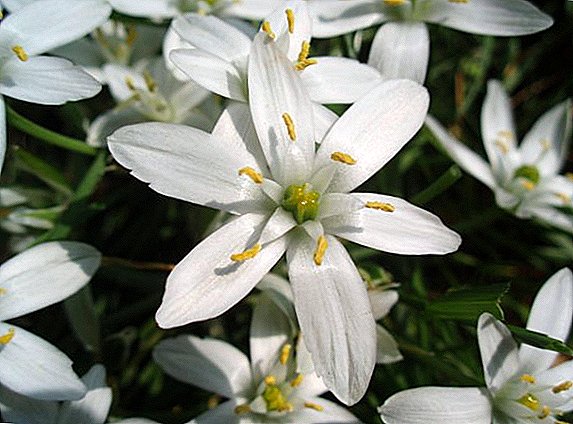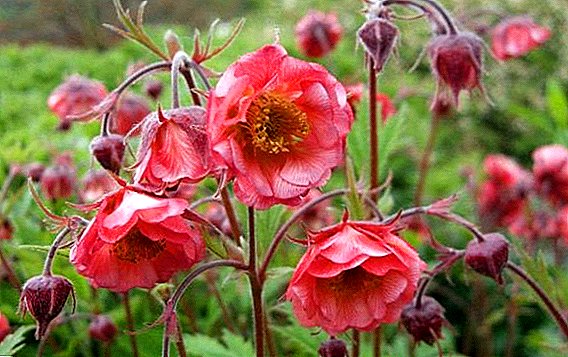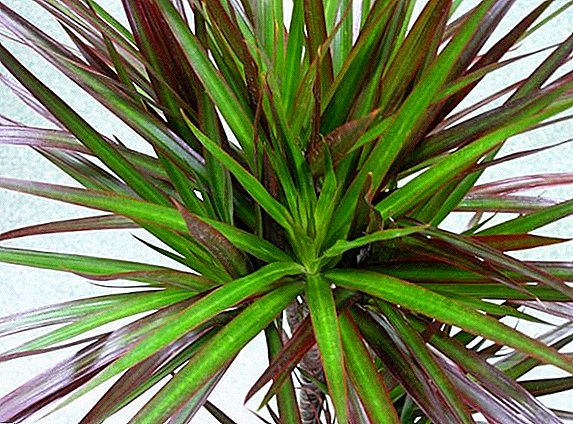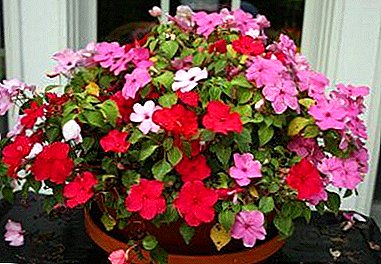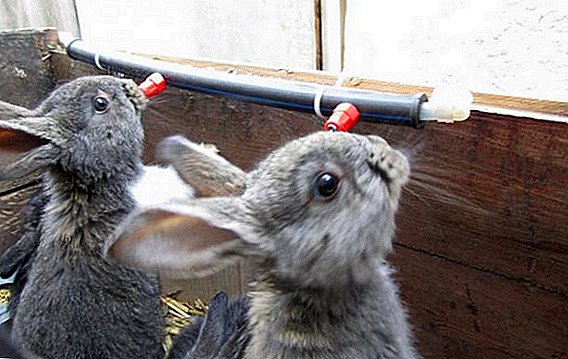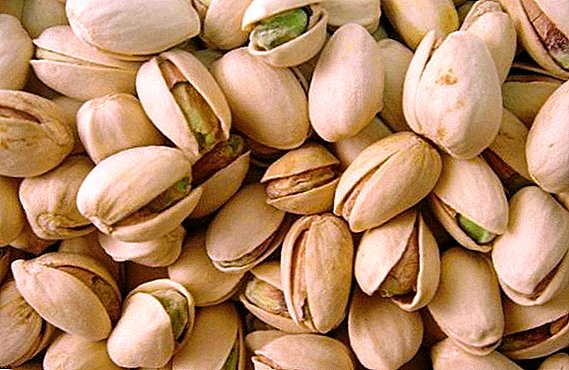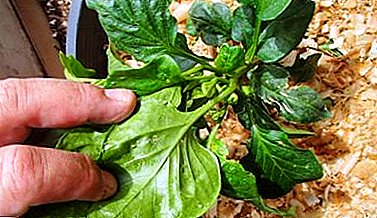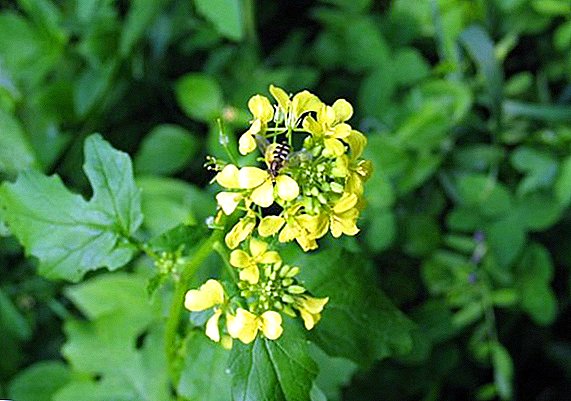 Soil fertilizer can be produced in two ways: artificial (external application of top dressing) and naturally - by sowing green manure. In this article we will look at oilseed radish from the point of view of sideratnogo use: what are its useful properties, how to properly plant and mow this plant.
Soil fertilizer can be produced in two ways: artificial (external application of top dressing) and naturally - by sowing green manure. In this article we will look at oilseed radish from the point of view of sideratnogo use: what are its useful properties, how to properly plant and mow this plant.
Botanical description
Latin name of the plant -Raphanus oliefera, belongs to the cabbage family. Radish came to us from Asia, it was there since ancient times that it was spread as a vegetable. In the wild is not found. Now she has gained wide popularity in North America and almost all of Europe.

Radish olive - an annual plant. Its maximum height is up to one and a half meters. Leaflets characteristic rugged shape. The fruit of this plant is not a full root vegetable, but only a small pod with seeds. The plant grows well in cold climatic conditions, which ensures its unpretentiousness to the weather. The difference between the oilseed species and the bitter habitual for us lies in the thin root and the presence of a large amount of essential oils, which is why it got its name.
This plant is not suitable for eating - it does not form edible fruits, unlike ordinary field radish or daikon (the closest relative of the plant). The main methods of application of oilseeds: as feed for livestock, green manure, honey plant and decoration of the soil.

The main beneficial properties of the plant
Despite the fact that oil radish is not an edible product for humans, and therefore, it can not bring benefits, however, it has many advantages.
Did you know? In ancient Greece, radish (only a "classic" bitter look) was in high esteem - it was served on a gold plate, and it was also paid for with pure gold, equal in weight to the root crop itself.
Like siderata
This plant is indispensable as a natural green fertilizer for the soil. Radish significantly enriches the soil - thanks to its long roots, it allows nutrients to be fed to a fairly great depth along its root canals. It protects the soil from erosion (especially during rainy months), retains moisture in the upper layer, and prevents drying. In addition, the radish affects the composition of the soil, its structure - it naturally loosens the earth, creating drainage even at great depths - this contributes to good ventilation of the soil and the penetration of moisture.

If the grass is not mowed for the winter period, it will rot and become a great fertilizer, saturating the upper layers of the soil. Remains of roots in the soil saturate the earth with minerals and beneficial trace elements such as nitrogen, potassium, phosphorus and others.
Radish also protects the soil and plants from the risk of developing a fungus. In addition, due to the darkening of the soil, radish does not give the opportunity to grow weeds (for example, couch grass and ragweed). Essential oils in the composition of the plant scare off such parasites as potato scab, aphid, nematode, caterpillar and so on.
Like honey plant
Such a plant is often planted not only to enrich and treat the soil, but as a source of sweet honey pollen for bees. Radish blooms for quite a long time - up to 40 days, and is also capable of producing nectar even in cool weather or in the absence of sunlight.

It blooms when most plants have already tied the fruit - thus providing food for the bees even during the flowering period of the other plants. Honey, formed from the pollen of this oilseed grass, has a very pleasant fragrant smell, and the content of essential oils makes it a healing product.
Important! Radish honey crystallizes very quickly, due to the high content of fructose, so it cannot be left in hives for winter - this will lead to the formation of a dense peel on the honeycomb.
Like feed crop
The positives of the radish in terms of the livestock industry is its rapid maturation, abundant shoots and nutritional value. So, from one hectare it is possible to collect up to 400 kg, and if additional feeding is added, the indicators can increase to 700 kg. Moreover, from the moment of planting the plant to the mowing it takes only 40-50 days, which allows you to carry out several turns per year - up to 4 mowing.
Also, as a stern culture they use: fodder beet, sorghum, pulses, triticale, amaranth
Livestock loves this herb both fresh and dry. - Radish produces remarkable flour, silage and haylage. Often, radish is mixed with peas, oats, corn - this nutritious food increases the milk yield of cows, and also affects the taste of milk. In animals that feed on such a bait, there is an improvement in the quality of wool, there is an increase in mass, and the likelihood of disease caused by parasitic insects is reduced.

Since this plant can grow up to the frosts themselves, this makes it possible to walk livestock, and allow it to independently pinch the grass even in late autumn.
As sideratov also used such plants as: rye, phacelia, alfalfa, lupine, mustard, sweet clover, oats, rapeseed
Application
There are many uses of oil radish, it is in demand not only in agronomy and agriculture.
In cooking
It turns out that, strictly speaking, inedible product, you can prepare quite tasty and nutritious dishes. Green mass is often used as a basis for salads. - it must first be soaked in cold water for about an hour. Also, the green shoots of the plant are added to the cabbage soup - due to the high content of ascorbic acid in its composition, radish saturates the dishes with useful components, and significantly increases their nutritional value.

In the food industry
The main nutritional value of this plant - the content of unique essential oils, which makes it possible to produce various enriched oils from it. However, this process is quite laborious, and therefore produce rare oil in very small quantities. Protein is also extracted from the radish (it makes up about 30% of the chemical composition of the plant), which is later used for dietary sports nutrition.
Did you know? The most popular essential oils are lavender, mint, lemon and orange, and the rarest - beeswax oil.
In pharmacology
Essential oil, and saturated rare essences are used as a basis for some medical preparations (mainly vitamins). There are herbal and teas with dried leaves of oil radish - drinks made from this herb have a calming effect, relieve stress and even headaches.

In cosmetology
Essential radish emulsions are often included in massage oils - when applied to the skin, this tool helps to relax and smooth the skin, and also has a slight warming effect. Essential rare oil is included in conditioners and hair balms - after applying such a remedy, a light honey smell remains on the hair, and the hair itself becomes shiny and silky.
Cumin, sage, beeswax, zizifus, okra, lagenaria, bergamot, cactus, chamomile, hops, rosemary are also used to strengthen hair.
In production
For industrial purposes, this plant is used to produce diesel fuel oil for combines and other technical machines. Also, an oily emulsion of radish is used to lubricate metal devices, thus protecting them from the formation of corrosion.

Technology for the cultivation of radish oilseed
To ensure the success of seedlings and a bountiful harvest, it is necessary to adhere to the correct technology of sowing this siderat.
Learn more about the features of the cultivation of radish, Chinese and black radish, as well as the use of radish in traditional medicine.
When to plant
Despite the fact that the plant is cold-resistant, you shouldn’t sow it in the frozen soil - it’s best to start the landing in early-mid-April. But the last sowing can be done until the end of August or the beginning of September - the last mowing of the grass you will have time to do before the onset of frost. If you sow the soil in early April and mow before the onset of flowering, then before the onset of winter, you can thus carry out a 3-4-fold aeration of the soil. In fact, it is possible to plant a radish during the whole warm period, but the best thing to do is:

- in the spring - after thawing of the soil (not earlier than the beginning of April);
- in the summer - at any time;
- autumn - no later than the beginning of September. In this case, the rate of seeds per 1 square. m need to increase widowed - in the later periods such a plant grows and matures much more slowly.
To cold-resistant plants also include: oregano, sorrel, catnip, statice, tiarella, arugula, creeping zhivuchka, Turkish carnation, miscanthus
Seeding rate
If your goal - to grow radish as a siderata, then it should be planted as follows: about 2 grams of seeds per 1 square meter. m. For livestock feed or the subsequent bevel for household needs, you can sow thicker: 4-5 grams per 1 square. m of land.

Soil and fertilizer
This crop should be planted in prepared soil. - the land must first be loosened. It is not recommended to plant this siderat on too hot a day or too dry ground - the effectiveness of seedlings may be halved. There is no need to use additional fertilizers and dressings - radish can also grow well on heavily impoverished soil.
How to sow
It is best to place such seeds in the ground by the method of placer: this will ensure more thorough sowing and seedling abundance (especially if the plant is planted with the aim of loosening the soil). For industrial purposes, such a plant is usually planted in rows - it is easier to collect and process it later. The distance between the beds make about 15-20 cm. The depth of sowing should be at least 3-4 cm, so the soil must first be plowed. If the seeds do not consolidate deep in the soil, they will simply be blown away by the wind or washed away by rain and will not have time to take root in the ground.

When using radish as a feed crop it is often sown together with peas - in this case, the proportions should be 1: 5 (the ratio of radish and peas).
In order to further collect the honey, the plant is sown in rows with a width of between 35-40 cm.
Important! Radish oil species is not suitable as a siderata for white cabbage, daikon, other species radish: these products are representatives of the same cruciferous family.
First shoots and mowing
The first small plant sprouts will seem out of the ground already for 4-5 days - especially if they were planted in the warm season (this time will double in the fall). Radish blooms within 40-42 days after the first shoots. For animal feed and harvesting of hay, the plant is usually cut before flowering occurs - this is about 38-40 days.

If the radish was planted as a siderata for winter plants, then cut it off 20 days before sowing winter crops. It is noteworthy that late sowing of radish is not suitable for the greening function - it is best to use late sowing as a stocking for livestock feed. If late crops do not bloom before the first frosts and snow, you can not mow them - they will keep the snow well on the ground, providing the latter with a natural shelter from the cold. In the spring, such a plant will quickly rot and will provide excellent fertilizing for spring crops of major crops.
We also recommend that you familiarize yourself with the natural dressings for your plants: banana peel, eggshell, nettle, onion peel, potassium humate, yeast, biohumus.
Radish oilseed is one of the most popular sideratov today. Due to its unpretentiousness to weather conditions, as well as its multifunctionality, it is often used both in a narrow industry - on household household plots, and on a large scale - on an industrial scale. The plant is not only one of the leaders in terms of the quality of aeration and fertilizer of the soil, but also shows great performance in the role of a honey bearing plant.


